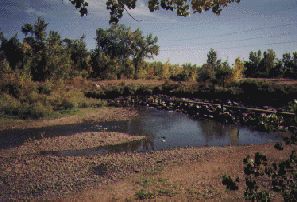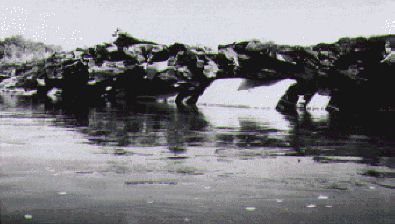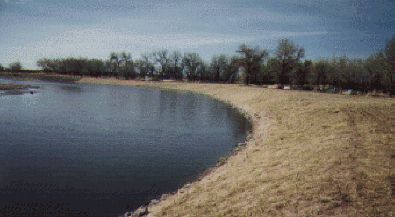

C-470 utility crossing before and after
South Platte River Program Notes
by
Ben Urbonas, P. E., Chief
and
Bryan W. Kohlenberg, P. E., Project Engineer
South Platte River Program
City and County of Denver
Last year the City and County of Denver launched a major South Platte River initiative. The Mayor set up a special commission with a diverse membership representing a variety of federal, state and local organizations with interests in technical, neighborhood redevelopment, political, fiscal, environmental and other issues. The commission is supported by a number of working groups that are addressing minimum river flows for a fishery and in-river recreation, trails and recreation along the river, water quality, wildlife, local flora and fauna, rafting and kayaking, aquatic habitat, open space needs, river stability, etc. As a result, these working groups and the commission are looking at the river and its potential from a holistic perspective. One of the outcomes of this effort is that Great Outdoors Colorado (GOCO) has awarded Denver a $6,000,000 grant for river parks and river habitat improvements.
The District is encouraged by this attention to the river and is working with Denver to implement some of the suggested improvements. Our primary involvement is in areas that address the river's stability, maintenance access, channel maintenance, flood control and related river improvements. All of the projects that we now fund or develop with Denver or other communities try to address all of the issues listed above as being addressed by Denver's South Platte River Commission.
Adams County
In 1995, Adams County also began a comprehensive look at the South Platte River corridor as a resource. In recent years urban development has resulted in pressures on the remaining open space resources along the river. Using a grant from GOCO the county constituted a steering committee consisting of county and city elected officials and "partners" work groups represented by a variety of interests, not unsimilar to what was done by Denver. The county also hired a consultant to inventory open space resource and recreational needs of the county and of various cities within the county. Using this information the consultant will work with the steering committee and the partners work groups to develop a plan for the acquisition and preservation of these resources. The District is represented on the partners group and is cooperating with the county to develop their South Platte River plan.
City of Littleton
Along the southern end of the South Platte River within the District, the City of Littleton and South Suburban Parks and Recreation District are working together to improve the river for rafting, kayaking and fish migration. The District was asked to assist with the installation of a boat and fish passage chute just downstream of Highway C-470. This is the site of a major sanitary sewer crossing that has been helping to control the river bottom from head cutting upstream.
Over the years the South Platte River channel bottom has incised downward, leaving this sewer line's encasement exposed. A five to six foot vertical drop had developed downstream of this line. This situation made safe boat passage impossible and eliminated the possibility for fish migration upstream.
The District had an interest to buttress the sewer line in order to stabilize the river from further degradation. We worked with the owners of the sewer line, City of Littleton and South Suburban Parks and Recreation District to install a partially grouted large boulder sloping buttress downstream of the sewer line. Since access was along property owned by the US Army Corps of Engineers, the Corps was asked to expedite needed permits. The Corps cooperated and expedited the issuance of all needed permits for this project.
The project was designed and constructed to provide for boater passage and fish
migration. To help with this function, the City of Littleton provided the services of an
expert in fisheries habitats to help us properly align the low flow chute for maximum
habitat enhancement. During construction care was taken not to disturb healthy stands of
sandbar willow on the east bank and to revegetate and restore all disturbed areas with
indigenous grass and shrub species. See the before and after photographs of the site
accompanying this article.
Routine Maintenance
In 1996, the South Platte River routine maintenance included an equivalent of 58 miles of trail edge mowing, tree trimming and pruning along 9 miles of the river trail, and trash and debris pickup and removal along 158 miles of the river. Over 50 truckloads of trash and debris were removed and taken to a landfill. These quantities do not include the trash picked up by local government personnel, volunteer groups, or the trash removed from trash receptacles maintained by park personnel along all recreational trails.
Although this type of routine maintenance often is not highly visible and often is not noticed or recognized by the public, without it the South Platte River corridor within the District would have an entirely different "look" and "feel." This type of maintenance we believe to be essential to provide the public with a more pleasant experience whenever visiting the many trail and pocket park facilities that now exist along the 41 miles of the South Platte River between Chatfield Reservoir and the Weld/Adams County line.
Restoration Maintenance
The restoration maintenance program continued to repair erosion damage along the combined recreation and maintenance trail; repair the trail and maintenance access bridges; cut and remove large numbers of dead elm trees in Adams County (Franklin Street to the Sand Creek confluence) which were the victims of a Dutch Elm Disease epidemic in 199293; restore a damaged water diversion structure's boat chute; and stabilize, rehabilitate, and revegetate approximately 1500 feet of river banks in the City of Brighton and in Adams County.
 |
 |
C-470 utility crossing before and after |
The largest restoration maintenance project in 1996 was the aforementioned sewer line buttressing project just downstream of Highway C-470 in Littleton's South Platte Park. A total of $210,000 was spent to design and construct this boulder buttress structure. Littleton and the owners of the sewer contributed $50,000 to help fund this much needed project. South Suburban Parks and Recreation District also contributed their time and organized volunteers to assist with the revegetation efforts - Thanks to all! We are pleased to say this project has received favorable comments from many who have seen it.
A second restoration project now under construction is a stretch of the west bank just north of 160th Avenue in the City of Brighton. The city recently acquired this property that contains a wonderful cottonwood grove in a relatively undisturbed natural area along the river. The river bank was undermined over the last few years, with many of the large trees now in danger of being lost. The District will rehabilitate and stabilize this bank and then revegetate it with indigenous riparian and dry land species.
Other restoration maintenance projects completed in 1996 include the reconstruction of approximately 50 feet of concrete maintenance access trail, which also serves as a recreational trail, at a large storm sewer outfall in north Denver; and the rehabilitation of a damaged boat chute and its maintenance access bench at the Overland Park Golf Course water diversion structure upstream of Florida Avenue.
This year we were pleased to work with young people from Fresh Start, Inc., a
not-for-profit organization that works with what some call "high-risk youth."
Their goal is to help the young people become motivated, capable, self-sufficient
individuals. Under the guidance of D. Grover, Dan Lee, and the District staff,
approximately 10 students formulated a revegetation site plan for the installation of
wetland plants in and around a large storm sewer outfall at Arizona Avenue in Denver. The
District provided the needed topsoil and plants while the students provided ingenuity,
enthusiasm, hard-work, fun and a job well done. Unfortunately, some of the plants were
washed out by high runoff before solid root growth could develop. We look forward to
working with this organization again in 1997.
 |
 |
Before and after views of Miles' river bank rehabilitation maintenance project. |
Miles Project
We have now completed the construction of this project that was started in 1995. Readers may recall last year we described how the U. S. Environmental Agency (EPA) issued to Mr. Miles an Administrative Order to remove unauthorized fill from his river bank property. Under the watchful eye of the EPA the District-hired contractor removed over 500 cubic yards of trash and debris, including broken asphalt, railroad track rails, tires, construction debris, and approximately 70 cubic yards of asbestos cement pipe. The latter required special removal and disposal procedures. It had been rumored that a car body or two might be found, but no such luck!
The newly restored bank is stabilized with buried riprap and revegetated with native grass and willows. See the photographs showing the before-and-after views of this project. Soon after completion and before vegetation could establish roots, a 5year flood flow of approximately 7,500 cfs occurred. This flow exposed much of the buried riprap and contributed to the mortality rate of the live staked willows. Next year we plan to revegetate this area again.
Cooley Gravel Project
The Cooley Gravel Cooperative Project north of 88th Avenue started in 1995 and is now 70 percent complete. This project installed one more sloping boulder river bottom degradation check structure. Cooley Gravel is providing the labor and equipment while the District is paying for the materials. The remaining bank rehabilitation work should be completed early in 1997.
Rogers Project
In exchange for a perpetual river flowage and maintenance access easement, the District
is now participating in the bank stabilization and rehabilitation of 1,100 feet of river
bank on the property owned by Mr. and Mrs. Jack Rogers. This west river bank project is
located just upstream of East 168th Avenue in Adams County. When completed, this project
will arrest active bank erosion that threatens to breach the existing berm between the
river and an adjacent active sand and gravel operation. This work should also arrest
abutment erosion at the 168th Avenue bridge. All work will be complete in spring of 1997.
Upper Central Platte Valley Project
During the last two years we have been cooperating with the City and County of Denver to develop and design the Upper Central Platte Valley Project. Since we last reported on this, an understanding has been reached with the Public Service Company of Colorado (PSCo), the owners of the Zuni Electric and Steam Generating Plant, to have its cooling system eventually converted to a closed loop recirculating system. When this is done, only 10% of the currently diverted water will need to be diverted. This will permit a change in the way cooling water is diverted from the river.
Since a recirculation system needs much less water than a pass-through cooling system, it may be possible to supply the plant with an infiltration gallery instead of a surface diversion system. If this proves to be feasible, the advantages are profound. First, all surface diversion structures disappear. Second, the options for river rehabilitation expand and allow for a more "natural" appearance and habitat alternatives. Third, there are more options available for integrating fish habitat, rafting, kayaking, other recreation uses and aesthetics into the finished product. Lastly, the problems associated with surface diversions, such as the presence of sediment and floatables in the water, disappear.
The District and its consultant are now testing a prototype section of an infiltration gallery installed in the river bottom upstream of the Zuni plant. We expect to "stress test" this section under conditions that exceed what an operational gallery would encounter. At the end of the test we want to have no doubts that the recommended design will work. The testing will take place over the next 12 months, but we hope to have sufficient data to determine if this option is feasible within the next six months. The second six months of testing will be used to improve the final design and to fortify our confidence in this facility. There is no room for failure. The power generating plant has to have a reliable source of cooling water when it operates, bottom line!
Globeville Area Project
The other capital project we wrote about last year is located in the Globeville neighborhood in north Denver. Phase I of the project is now under construction. It covers 2,000 feet of the South Platte River. Although flood control is one of the primary reasons for this project, the improvements also focus on river bank rehabilitation and on improvements to a recreational trail, aquatic and terrestrial habitat, and on community access to the river. The design of Phase II, encompassing 5,000 feet of the river upstream of Phase I, is under way. We expect construction of Phase II to begin in October of 1997.
The funding for the final phase of this project, which is immediately downstream of Phase I, has yet to be secured. Denver and the District are exploring various ways to fund it. It is the key phase for flood protection. Without it the upstream two phases will not have sufficient capacity to protect the Globeville neighborhood and some of Adams County immediately downstream. At $6,000,000 it is also the most expensive and complex element of the entire project. Nevertheless, we hope to have it under construction within the next two to three years as well.
Once the project is fully completed, approximately 300 acres of inner-city existing
residential, industrial and commercial area will be removed from the 100-year regulatory
floodplain. In addition, 7,000 feet of the river's channel will have been rehabilitated;
and a recreational trail separated from traffic and connected to the Adams County's trail
system, and the community's access to the river and the environment for this old
neighborhood of Denver will be significantly improved.
We have now completed the removal of infected dead Siberian Elm trees along the South Platte River through Denver and southern Adams County. Since this work was started in August of 1995, a total of about 1,500 trees have been cut and chipped.
The District and Denver Parks and Recreation Department have entered into an agreement
to fund the replacement of two rapidly deteriorating timber pedestrian/ maintenance access
bridges spanning the river. Over the next three to five years we hope to work with Denver
to replace the deteriorating timber bridges that are still in service. The new steel
bridges will require less maintenance and be much easier to use by maintenance equipment
operators due to wider decks. They will also permit bikers, roller bladers and hikers to
use these crossings with less conflict.
Table of Contents
| Return to UDFCD Home Page